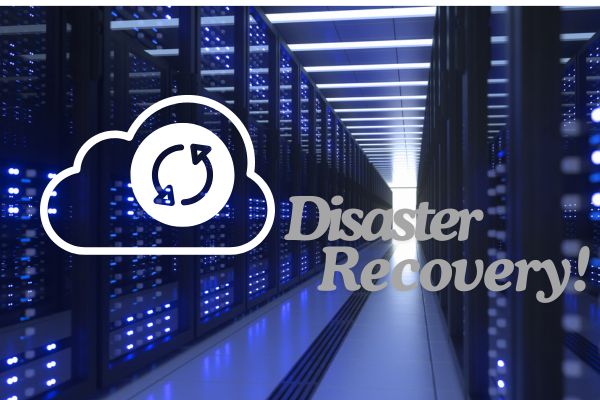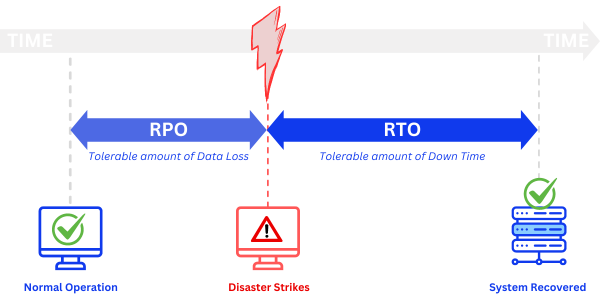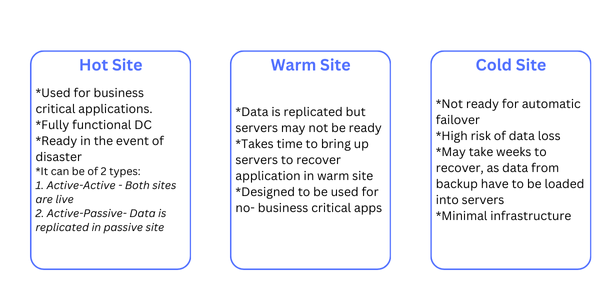
Safeguarding Your Business from the Unexpected
In today’s fast-paced digital world, businesses rely more on technology than ever before. With this dependency comes an inherent risk: disasters, whether natural or man-made, that can disrupt operations, cause data loss, and lead to significant financial and reputational damage. Disaster Recovery(DR) is the structured approach organizations must adopt to ensure they can quickly recover from such incidents and resume normal operations with minimal disruption.
What is Disaster Recovery?
Disaster recovery is a set of policies, tools, and procedures designed to recover and protect an organization’s IT infrastructure and data. Disruptions can vary in severity, from minor issues like brief power outages, DIMM issues or disk failures to major incidents such as site destruction, natural calamities or fires. While many of these vulnerabilities can be reduced or managed through operational, technical, or administrative controls as part of an organization’s resilience strategy, it remains nearly impossible to eliminate all risks entirely.
Unlike traditional backups, which are a part of disaster recovery, DR goes beyond simply restoring lost data. It involves a holistic approach to getting systems up and running again, ensuring employees can work and customers can interact with your business, even after a major disruption.
Why Disaster Recovery Matters?
Every organization, regardless of its size, is vulnerable to disasters. Disasters can occur unexpectedly, causing significant socio-economic and reputational damage. Here are some compelling reasons why disaster recovery is crucial:
- Minimizing Downtime: Unplanned outages can halt business operations, leading to loss of revenue, productivity, and customer trust. A robust DR plan ensures that downtime is minimized.
- Preventing Data Loss: Data is the lifeblood of most modern businesses. Losing it can mean losing customer information, transaction history, and intellectual property. DR helps prevent permanent data loss.
- Meeting Compliance Requirements: Many industries are subject to regulations that mandate data protection and recovery processes. Non-compliance can result in heavy fines or legal consequences.
- Mitigating Cybersecurity Risks: With the rise of ransomware, data breaches, and other cyberattacks, having a disaster recovery plan that includes data encryption and multiple recovery points is essential.
Key Elements of a Disaster Recovery Plan
A disaster recovery plan must be thorough, strategic, and well-tested. Below are the key components of an effective DR plan:
1. Risk Assessment and Business Impact Analysis (BIA):
- Risk Assessment: Identify potential threats such as hardware failures, cyberattacks, natural disasters, and human errors. Assess the likelihood and impact of each risk on your business.
- Business Impact Analysis: Analyze how these threats affect critical systems, applications, and data. This will help prioritize recovery efforts.
2. Recovery Objectives:
- Recovery Time Objective (RTO): This defines the maximum amount of time that critical systems can be down before causing irreparable harm to the business.
- Recovery Point Objective (RPO): This determines the maximum acceptable amount of data loss, measured in time. For example, an RPO of 1 hour means you should never lose more than 1 hour’s worth of data.

| Recovery Time Objective (RTO) | *RTO refers to the time an application can be down without causing significant damage to the business * It answers the question, “How quickly do we need to recover after a disaster?” * Applications should be ranked by importance and potential business loss so that the most critical ones are dealt with first. * Applications requiring near zero RTO require failover services * Example: If your RTO is 2 hours, your systems must be restored and operational within 2 hours after a failure or disaster occurs. |
| Recovery Point Objective (RPO) | * RPO refers to the maximum acceptable amount of data loss measured in time. * It answers the question, “How much data can we afford to lose?” * Depending on application priority, individual RPOs can typically range from 1 day, to 12, to 8, to 4 and further down to near-zero measured in seconds * Near-zero RPOs will require continuous replication * Example: If your RPO is 1 hour, this means that you must have backups or replication of data no older than 1 hour. In the event of a disaster, you could lose up to 1 hour of data and still meet your recovery goals. |
3. Data Backup Strategy:
A key part of disaster recovery is maintaining secure and reliable backups. There are various methods:
- Onsite backups offer quick recovery but are vulnerable to the same disasters that impact the primary site.
- Offsite or cloud backups provide better protection by storing data in remote locations, unaffected by localized disasters.
4. Failover and Redundancy:
Failover ensures that secondary systems automatically take over when the primary systems fail with minimal disruption. This is often done using:
- Cold Sites: A cold site is a backup location where data and systems can be restored, but it has no pre-installed hardware or active infrastructure. In the event of a disaster, the site needs to be set up from scratch, which may result in longer recovery times. Cold sites are cost-effective but slower to bring online.
- Warm Sites: A warm site offers a middle ground between cold and hot sites. It is partially equipped with some hardware and infrastructure already in place, such as servers and networking equipment. Data and applications may be updated periodically, but it still require some configuration before becoming fully operational. Warm sites provide a balance between cost and recovery speed, offering faster recovery than cold sites but at a lower cost than hot sites.
- Hot Sites: A hot site is a fully operational backup facility that mirrors the primary site in real time, with live data replication and fully functional systems ready to take over instantly. Hot sites ensure the shortest recovery time but are more expensive to maintain due to the constant updating and replication of systems.

5. Communication Plan:
A disaster doesn’t just impact IT systems. You need a clear communication strategy for keeping employees, customers, and stakeholders informed throughout the recovery process. This plan should identify key contacts and outline roles and responsibilities.
6. Testing and Maintenance:
A disaster recovery plan is only effective if it works during a real crisis. Regularly test the plan by simulating various disaster scenarios. This will help identify any weaknesses and ensure that all team members are familiar with the recovery procedures.
Types of Disaster Recovery Solutions
There are several approaches to disaster recovery, and the best option depends on your organization’s size, budget, and needs:
- Cloud-Based Disaster Recovery: Cloud DR solutions provide geographic redundancy, scalability, faster recovery and cost savings by eliminating the need for physical hardware. These services allow organizations to replicate their systems in the cloud, making recovery seamless and fast. Cloud DR providers, like AWS Disaster Recovery, offer pay-as-you-go models, making it affordable for businesses of all sizes.
- Hybrid Disaster Recovery: A hybrid approach involves combining on-premises and cloud-based solutions. For example, an organization might back up critical data to both an onsite server for quick recovery and the cloud for additional protection against catastrophic failures.
- Disaster Recovery as a Service (DRaaS): DRaaS providers offer full disaster recovery solutions, including data replication, system backups, and failover services. With DRaaS, businesses can outsource their entire disaster recovery process to experts specialising in minimizing downtime and ensuring rapid recovery.
Conclusion
In an era where businesses heavily depend on technology and data, having a comprehensive disaster recovery plan is no longer optional—it’s essential. Disasters, whether natural or man-made, can strike without warning, leading to devastating financial and reputational losses. By implementing a robust disaster recovery strategy, organizations can minimize downtime, prevent data loss, ensure compliance with regulations, and protect against cybersecurity threats. From cloud-based solutions to failover mechanisms like cold, warm, and hot sites, the right disaster recovery plan will ensure your business can recover quickly and efficiently, no matter the disruption. Preparing today means safeguarding the future of your operations, customers, and reputation.


